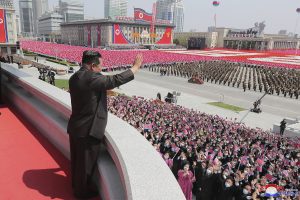It’s been a busy 2022 for North Korea. After a record-setting spate of missile launches in the first month of the year, things quieted down during the Beijing Winter Olympics. Then North Korea tested an intercontinental ballistic missile (ICBM), the first such test in five years. Satellite imagery has analysts concerned that a nuclear test is on the way as well, which would bring the Korean Peninsula back to the bad old days of “fire and fury” seen in 2017.
For more insight into North Korea’s recent military actions – and its goals – The Diplomat interviewed Jenny Town and Joel Wit of 38 North, a website dedicated to analysis of North Korea hosted by the Stimson Center. Town is a senior fellow at the Stimson Center and the director of Stimson’s 38 North Program. Wit is a distinguished fellow in Asian and Security Studies and the founder of 38 North.
April 15, the Day of the Sun, is an important public holiday in North Korea. Can you give us a quick overview of the significance of April 15 for North Korea, and how the latest celebration fits into that context?
Jenny Town: April 15 is one of North Korea’s most important holidays, commemorating the birthday of the country’s founder, Kim Il Sung. It is usually marked by large-scale parades, sometimes military parades, that roll through Kim Il Sung Square and are overseen by the leader. This is a time for the regime to reinforce political ideology, call for national unity and project an image of strength. This year marks the 110th birthday of Kim Il Sung and Kim Jong Un’s 10th year as leader, and celebrations were expected to be big, given signs of parade preparations observed in satellite imagery over the last few weeks, the build-up of WMD achievements over the past few months, and the recent issuance of a commemorative stamp for Kim Jong Un’s 10 year anniversary.
Kim Jong Un, through the combination of festivities around both April 15 and April 25, appears to have wanted to impress upon the North Korean people the that country is still strong despite both the worsening international security situation and the hardships of the pandemic. Whether the people will view it that way when the cameras go dark, the food situation is still dire, and economic opportunities are still limited due to pandemic restrictions is unclear. At the very least, the showcasing of the recent new missiles tested in recent months and yet another new missile help Kim demonstrate his ability to achieve national goals and also project this notion of maintaining peace through strength.
Furthermore, the increasing emphasis on an evolving nuclear doctrine is partially in response to some of the harsher rhetoric coming out of Seoul these days, from the incoming Yoon administration. It also serves as a sort of reassurance that, because of its nuclear weapons, North Korea will not suffer the kind of invasion Ukraine is experiencing now or the fate of other non-nuclear armed states against nuclear armed adversaries in the past.

































